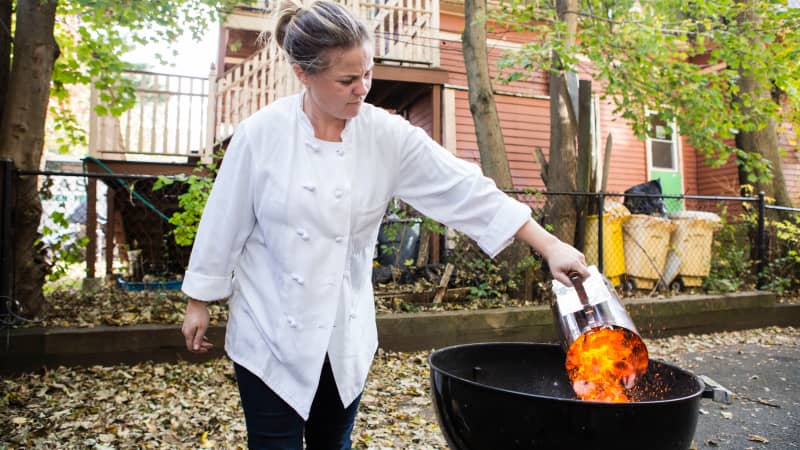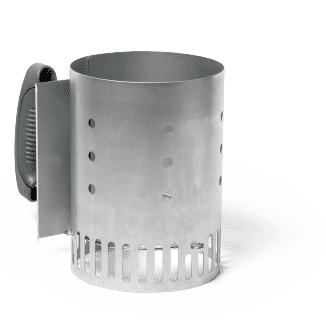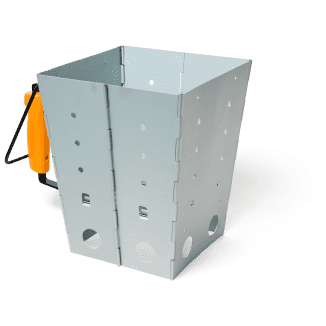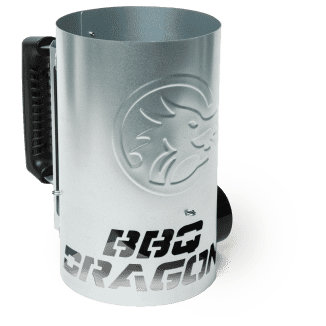Lighter fluid is petroleum- or alcohol-based, so it can impart unpleasant flavors to grilled food. This is why we always use a chimney starter instead to light charcoal. These simple devices, shaped like giant metal mugs, generally consist of a cylindrical body with a handle and two stacked chambers: the top one for charcoal and the bottom one for the fuel used to light that charcoal, typically newspaper or a charcoal starter (we prefer two gently crumpled sheets of newspaper).
We've used the Weber Rapidfire Chimney Starter for years, but it's been slightly updated with a more ergonomic handle since we last tested, and there are new options on the market that promise to make the whole process faster and easier. So is our old winner still the best? To find out, we rounded up several widely available chimney starters, including the updated version of our former favorite.
We put the chimney starters to work, using them to light various amounts of charcoal and pour the briquettes out in different formations to represent the many ways we cook on a grill, from quick, high-heat recipes such as traditional burgers to low-and-slow projects such as pulled pork. For full-size models, we started with the most basic coal formation, 6 quarts of charcoal in a single-level fire. Then we tried a smaller amount, 3 quarts (often referred to as a “half chimney”), in a two-level fire, in which the coals are banked on one side of the grill to create a hotter zone and a cooler zone. Lastly, we tested with another two-level charcoal formation, using the maximum amount of charcoal we typically call for, 7 quarts. We timed how long it took to light the coals, rating each starter on how much charcoal it could hold and how easy it was to use. For smaller models, we filled them to their maximum capacities and used them to light charcoal in charcoal smokers, timing how long it took and rating them on how easy they were to use.

A Faster Fire
It can take a while for a chimney to bring its charcoal from cold to evenly dusted with ash (the visual cue we use to determine the charcoal's readiness)—between 20 and 40 minutes, depending on the amount of charcoal. We studied the design of the chambers, but none of the starters' ventilation features consistently tracked with faster, easier-to-light fires. One thing that did make a difference: the size of the starter's fuel chamber, the space on the bottom where the newspaper goes. One of the models had an exceptionally small fuel chamber thanks to a large pipe that was ostensibly designed to pull in more oxygen to fuel the fire but took away some of the usable space. In this instance, the two sheets of newspaper that we'd typically use were too cramped to allow oxygen to circulate, so we had to light them again and again. And one sheet wasn't quite enough fuel to get the coals really going; they just smoldered until we had to lift the whole shebang to carefully tuck in more newspaper. Starters with medium-size chambers were able to light the coals, but bigger was better: Our top-rated chimney starters had spacious fuel chambers of at least 127 cubic inches, allowing them to reliably ignite coals faster without needing more fuel.

Small Capacity Was Usually a Deal Breaker
Still, capacity of the top chamber, which houses the charcoal, was even more important. Some of the starters had charcoal chambers that were too small; they could fit only 5 quarts of charcoal, or about 80 briquettes, instead of the 6 or 7 quarts called for in many of our grilling recipes. This was a deal breaker for most grilling situations. If you don't use enough charcoal, your fire won't get hot enough to properly sear your food and may die out before the food finishes cooking. There's nothing quite as annoying and dicey as having to lift a hot, food-laden grate to dump in more charcoal. The other three models had roomy charcoal chambers of 290 cubic inches or larger; they fit up to 7 quarts of briquettes, enough to cover all our standard grilling recipes so we never have to stop and refuel.
That said, there are a few situations in which you might actually want a chimney starter with a smaller capacity. If you frequently grill in a portable charcoal grill or use your chimney starter to light a charcoal smoker, you don’t need to light as many briquettes to begin with. Of course, you could still use a full-size chimney starter in these scenarios, loading it with fewer briquettes, but a more compact chimney starter can more easily be transported on camping trips and maneuvers more nimbly in narrow spaces such as those found in some charcoal smokers.
Comfort and Stability Are Key When Handling Hot Coals
We need to feel safe and secure when we're wielding pounds of sparking, ashing, orange-hot embers, so ease of use was also hugely important. One model's handle was partially blocked by a metal trigger designed to release its coals; we had to awkwardly maneuver around it every time we needed to grip the handle to move the starter. Two narrow wooden handles felt insubstantial and tended to get hot. A large, accessible plastic handle that stayed cool was key.
Also useful: a helper handle. Two of the starters sported a second thin metal handle that was great for supporting heavy loads and guiding the starter when dispersing the coals.

Chimney shape mattered, too. One model was square, while the other five were cylindrical. The square model was collapsible for easy storage, but testers found it harder to pour from in a controlled manner—the coals flew off the straight edge in all directions. We tried to tilt it to pour from a corner, but because of the handle's location along one of the flat sides, we had to hold it at an awkward angle, which didn't afford us any better control while dispersing the coals. This model's collapsible construction also made it feel a bit rickety; it never threatened to fold up on us mid-use, but testers felt it had too much give to feel perfectly secure.
Overall, testers preferred the classic cylindrical design. The rounded edge helped funnel the coals out of the starter in a more directed manner, and noncollapsible construction felt sturdier—a critical consideration when you're handling red-hot coals.
In the end, the Weber Rapidfire Chimney Starter was still the best chimney starter on the market. It had roomy chambers: The bottom one was large enough for plenty of fuel, and the top one fit enough charcoal for all our grilling recipes. Its sturdy cylindrical body was easy to pour from in a controlled manner, and its two handles were comfortable and stayed cool for safe and secure handling. The icing on the cake: It was also one of the cheapest models we tested. We also liked its smaller sibling, the Weber Rapidfire Compact Chimney Starter. It holds a little less than half the briquettes that our top pick does, but its more petite profile makes it ideal for camping trips and for use with charcoal smokers.
The Tests
- Light 3 quarts of charcoal (50 briquettes); pour into a single-level fire formation. Repeat with grill gloves on
- Light 6 quarts of charcoal (100 briquettes); pour into a two-level fire formation. Repeat with grill gloves on
- Light 7 quarts of charcoal (115 briquettes); pour into a two-level fire formation. Repeat with grill gloves on
- Have three users evaluate the three models that held at least 6 quarts of charcoal
- Drop from grill height three times
- Coat with water, leave outside for five days, and then inspect for rust
How We Rated
- Capacity: We loaded each starter with the amount of briquettes required for 3-quart (50), 6-quart (100), and 7-quart (115) chimneys, as well as two sheets of newspaper in the bottom chamber. Those that could securely hold up to 7 quarts of charcoal and two sheets of newspaper in the appropriate chambers rated highest.
- Ease of Use: We rated the starters on how comfortable, secure, and easy they were to load with charcoal and newspaper, light, lift, and pour from. Sturdy cylindrical models with large fuel chambers; comfortable, stay-cool handles; and secondary helper handles rated highest.
- Large charcoal chamber that fits 7 quarts of charcoal, mounded
- Large newspaper chamber to allow for two sheets of paper and sufficient airflow
- Comfortable, stay-cool main handle
- Helper handle to support heavy loads and guide pouring
- Sturdy cylindrical body for easy charcoal dispersal and secure handling














